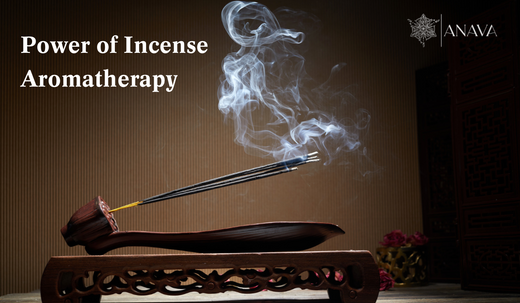Introduction
Human minds are constantly hijacked by external events and distractions that reduce mental power to an unbearable level. Studies have shown that practising MINDFULNESS help enormously to heal the mind on a deep subconscious level.
Integrating mindfulness practises can ease your anxieties and heal the subconscious in the long run, and one of them is using incense during meditation and yoga.
The question is, how can incense have a tremendously relaxing effect on our subconscious mind?
The use of incense during meditation and yoga has been a common practice for centuries, with its influence on the subconscious mind being a subject of interest and study. The aroma of incense has been found to have a calming effect on the mind and body, promoting relaxation and deepening the meditative state. This is due to the direct impact of certain scents on the limbic system of the brain, which is responsible for emotions, memories, and arousal.
In addition to its calming effect, incense has also been found to enhance focus and concentration during meditation and yoga. Certain scents, such as sandalwood and frankincense, have been specifically associated with promoting mental clarity and spiritual awareness.
Science Of How Incense Affects The Subconscious Mind
The science of how incense affects the subconscious mind is rooted in how our brain processes scents and their profound impact on emotions, memories, and mental states.
Here's a breakdown of the key scientific concepts:
1. The Olfactory System and Its Direct Link to the Brain
- Olfactory Pathway: When we inhale the aroma from incense, scent molecules travel through the nose to the olfactory receptors, specialised cells in the nasal cavity. These receptors send signals directly to the brain's olfactory bulb, which is a part of the limbic system.
- Limbic System: The limbic system is the brain's emotional centre, responsible for regulating emotions, behavior, and long-term memory. Because the olfactory system is directly connected to the limbic system, scents can evoke immediate emotional responses and influence subconscious processes without conscious thought.
2. The Role of the Limbic System
- Emotional Response: The limbic system includes structures like the amygdala and hippocampus, which are key in processing emotions and memories. When a scent from incense is detected, it can trigger emotional responses, such as calmness or alertness, depending on the scent.
- Memory and Conditioning: The hippocampus, another part of the limbic system, is involved in memory formation. This is why certain scents can trigger vivid memories or emotions from the past, influencing our subconscious mind by associating specific scents with particular experiences or feelings.
3. Aromatherapy and Psychological Effects
- Aromatherapy Science: Aromatherapy is based on the use of scents to promote psychological and physical well-being. Scientific studies have shown that certain essential oils, which are often components of incense, can influence brain activity and emotional states. For example:
- Lavender: Known for its calming effects, lavender can reduce anxiety and promote relaxation by decreasing the activity of the sympathetic nervous system, which is responsible for the body's "fight or flight" response.
- Sandalwood: Often used in meditation, sandalwood has been shown to enhance focus and promote a sense of inner peace.
- Neurochemical Changes: Inhalation of certain aromas can lead to changes in brain chemistry. For example, lavender can increase the production of serotonin, a neurotransmitter associated with mood regulation, thereby helping to reduce stress and anxiety.
4. Incense and the Subconscious Mind During Meditation and Yoga
- Stress Reduction: The soothing scents of incense can activate the parasympathetic nervous system, which counteracts stress and promotes relaxation. This creates an ideal mental state for meditation or yoga, where the mind can focus inward.
- Focus and Mindfulness: The consistent use of specific incense scents can act as a mental trigger, signaling the brain to enter a state of focus and mindfulness. Over time, the subconscious mind begins to associate these scents with calm and focused states, making it easier to achieve these states during practice.

Benefits of Using Incense During Meditation
Using incense during meditation can enhance the overall experience by creating a calming atmosphere and influencing the mind in various positive ways. Here are some key benefits:
1. Enhances Relaxation
- Incense like lavender, sandalwood, or frankincense can help calm the nervous system, reduce stress, and create a serene environment conducive to deep relaxation.
- The soothing aromas of certain incense can lower cortisol levels (the stress hormone), promoting a sense of peace and tranquillity that is ideal for meditation.
2. Promotes Focus and Concentration
- Scents such as peppermint, rosemary, or sandalwood can stimulate the mind, helping to clear mental fog and improve concentration during meditation.
- The repetitive act of lighting incense and the continuous presence of a familiar scent can help the mind focus and reduce external distractions.
3. Supports Mindfulness
- The scent of incense can serve as an anchor to the present moment, helping to ground the mind and enhance mindfulness during meditation.
- The subtle scent of incense can heighten sensory awareness, making the practitioner more attuned to their surroundings and internal states.
4. Creates a Sacred Space
- Incense has been used in spiritual practices for centuries to create a sacred, meditative environment. The act of lighting incense can symbolize the transition into a spiritual state of mind.
- Lighting incense before meditation can serve as a ritual that prepares the mind and body for the meditative practice, helping to establish a consistent routine.
5. Deepens the Meditative State
- Certain incense ingredients, like sandalwood and frankincense, have been shown to promote alpha brainwave activity, which is associated with relaxed yet alert states, deepening the meditative experience.
- Regular use of the same incense during meditation can condition the mind to quickly enter a meditative state upon recognizing the scent.
Benefits of Using Incense During Meditation
Using incense during meditation can enhance the overall experience by creating a calming atmosphere and influencing the mind in various positive ways. Here are some key benefits:
1. Enhances Relaxation
- Incense like lavender, sandalwood, or frankincense can help calm the nervous system, reduce stress, and create a serene environment conducive to deep relaxation.
- The soothing aromas of certain incense can lower cortisol levels (the stress hormone), promoting a sense of peace and tranquillity that is ideal for meditation.
2. Promotes Focus and Concentration
- Scents such as peppermint, rosemary, or sandalwood can stimulate the mind, helping to clear mental fog and improve concentration during meditation.
- The repetitive act of lighting incense and the continuous presence of a familiar scent can help the mind focus and reduce external distractions.
3. Supports Mindfulness
- The scent of incense can serve as an anchor to the present moment, helping to ground the mind and enhance mindfulness during meditation.
- The subtle scent of incense can heighten sensory awareness, making the practitioner more attuned to their surroundings and internal states.
4. Creates a Sacred Space
- Incense has been used in spiritual practices for centuries to create a sacred, meditative environment. The act of lighting incense can symbolize the transition into a spiritual state of mind.
- Lighting incense before meditation can serve as a ritual that prepares the mind and body for the meditative practice, helping to establish a consistent routine.
5. Deepens the Meditative State
- Certain incense ingredients, like sandalwood and frankincense, have been shown to promote alpha brainwave activity, which is associated with relaxed yet alert states, deepening the meditative experience.
- Regular use of the same incense during meditation can condition the mind to quickly enter a meditative state upon recognizing the scent.

Benefits of Using Incense During Yoga
Using incense during yoga can significantly enhance the practice by creating a harmonious atmosphere and positively impacting the mind and body. Here are some key benefits:
1. Supports Energy Cleansing
- Many traditional practices use incense for cleansing and purifying the energy of a space. Burning incense during yoga can help clear negative energy, creating a positive and uplifting environment for practice.
- Certain incense, such as citrus or mint, can have an energizing effect, helping to revitalize both the body and mind, especially during morning or vigorous yoga sessions.
2. Enhances Focus and Concentration
- Scents like frankincense and cedarwood can help clear mental clutter, allowing practitioners to focus more deeply on their breath, alignment, and movements.
- The continuous presence of a gentle scent can help anchor the mind, reducing distractions and encouraging a more centred and focused yoga practice.
3. Supports Deep Breathing
- Incense can enhance the awareness of breath, a core component of yoga. Scents like eucalyptus or peppermint can invigorate the senses and encourage deeper, more mindful breathing.
- Certain incense, especially those with refreshing scents like eucalyptus or pine, can help open up the airways, making it easier to breathe deeply and fully during yoga.
4. Enhances Mind-Body Connection
- Earthy incense such as patchouli or vetiver can help ground the body and mind, fostering a stronger connection between physical movements and mental awareness.
- The ritual of lighting incense before practice can help set the tone for mindfulness, encouraging practitioners to remain present and aware throughout the session.

Choosing the Right Incense for Your Meditation & Yoga Practice
Different scents have various effects on the mind and body, so it's essential to select one that aligns with your goals and preferences. Here's a guide to help you choose the best incense for your practice:
1. Lavender
- Benefits: Known for its calming and soothing properties, lavender incense can help reduce stress and anxiety, making it ideal for meditation focused on relaxation and mindfulness.
- Best For: Stress relief, sleep meditation, and gentle yoga practices like Yin or Restorative yoga.
2. Sandalwood
- Benefits: Sandalwood is a popular choice in spiritual practices for its grounding and centering effects. It helps deepen meditation and promotes a sense of peace and calm.
- Best For: Deep meditation, spiritual yoga practices like Kundalini or Hatha yoga, and grounding exercises.
3. Frankincense
- Benefits: Frankincense has been used in religious and spiritual rituals for centuries. It enhances focus, clarity, and spiritual connection, making it a great choice for meditation and yoga practices that involve chanting or prayer.
- Best For: Spiritual growth, concentration, and practices like Bhakti yoga or transcendental meditation.
4. Rose
- Benefits: Rose incense is associated with love, compassion, and healing. It’s ideal for meditations focused on the heart chakra and practices that aim to cultivate self-love and kindness.
- Best For: Heart-opening meditations, loving-kindness practices, and gentle yoga.
5. Oud
- Benefits: Oud incense, made from the resinous heartwood of the agarwood tree, is one of the most prized and luxurious incense materials in the world. Benefits are spiritual connection, emotional balance, cleansing, purification, sleep aids, enhanced focus and clarity, antibacterial properties and aphrodisiac qualities.
- Best For: Oud incense is particularly well-suited for meditations and yoga practices that focus on deep spiritual connection, grounding, and emotional balance.
Conclusion
From the above explanation, we can see how meditation and yoga deeply affect our subconscious mind inducing relaxation, pattern breaking, access to the higher mind, spiritual ascension and much more. Additionally, the aromatic experience provided by incense helps create a sacred and calming environment, promoting relaxation, focus, and emotional release. By selecting the right scents, such as sandalwood for grounding or lavender for relaxation, you can tailor your practice to meet your specific needs and goals. The ritual of lighting incense can signal the start of a transformative journey inward, allowing you to tap into your subconscious mind more readily.
References
- https://adwaityoga.com/how-meditation-affect-the-subconscious-mind/#google_vignette
- https://www.asttrolok.com/public/blog/how-yoga-can-open-your-subconscious-mind#:~:text=Yoga%20can%20activate%20pleasant%20thoughts,your%20lower%20and%20higher%20consciousness.
- https://www.google.com/search?q=Best+Incense+Fragrances+for+Enhancing+Yoga+and+Meditation+Experiences&oq=Best+Incense+Fragrances+for+Enhancing+Yoga+and+Meditation+Experiences&gs_lcrp=EgZjaHJvbWUyBggAEEUYOdIBCDEwNDJqMGo5qAIAsAIB&sourceid=chrome&ie=UTF-8











